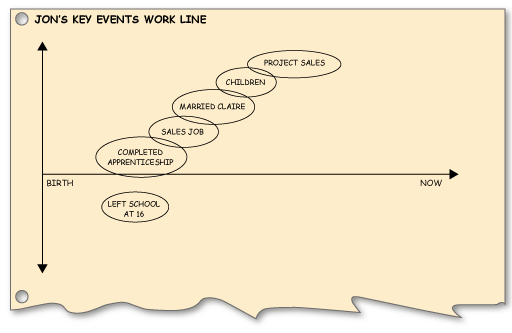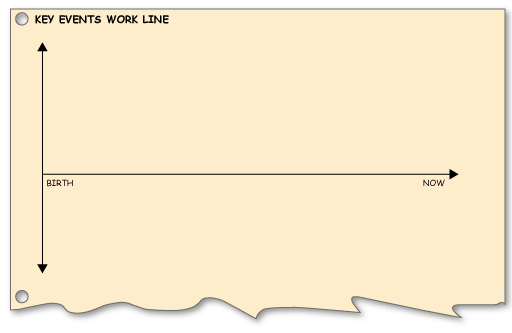4 What am I like?
You are bringing to this course a wealth of life experiences. These have shaped your interests and aspirations, and have coloured what you believe and care about. Often we take these aspects for granted or are unaware of how they affect the decisions we take. So, it is helpful to bring these to the surface or rediscover them, so that you can decide if they are still relevant for you.
One way of doing this is to create a ‘work line’, which helps you to think about the pattern of your work life. Producing a work line helps to give shape to the past rather than it feeling like a confusing jumble of events and experiences. This is the next step towards considering the future and moving forward.
Figure 5 is an example of what a work line might include and look like.
Depending on your age, you may have many or fewer life experiences to draw on. Focus on the ones that seem significant to you in relation to your work-life. For instance, if you are only just out of education, you might want to think about success in particular subjects, about teachers or tutors who were influential, or about friends who affected how you see yourself and your place in the world.
Activity 5 My work line
First note down key events in your work and study life, to show the high and low points at different times of your life. Only include events that you feel comfortable with.
For some people, the work line exercise can result in a lot of emotions coming to the surface as you review your experiences. You may find it useful to talk through any difficult emotions with someone you trust.
Create your own work line diagram, either by downloading and printing a copy of Figure 6 below from the Resource pack [Tip: hold Ctrl and click a link to open it in a new tab. (Hide tip)] and completing it, or by drawing your own.
Now you’ve drawn your work line, consider it as a whole. Then use the following questions to help you to make sense of what your work-line is showing you. Note down your thoughts in your notebook.
- Does the work line say anything about you and how you have lived your life?
- Can you spot any themes that seem to repeat themselves? Or, if the themes are not clear yet, are there any major or significant turning points?
- What is the overall pattern like? Is it generally up or down, steady or changeable?
- Are there any lessons you can draw from your work line?
Comment
For most people this can be a tough activity, so well done for giving it a go. Again, the notes you have made will be very personal to you and different from other people. Here’s one example of what was noticed by someone who did this activity, which they hadn’t been aware of before:
One person found she had moved location a lot in her life, and that these events tended to be associated with high points. She realised that she loved travelling to new places, but soon got bored again and wanted to move on. A valuable insight, that would help her plan her future.
Did you notice anything similar in your work line? You might not have done and that’s perfectly ok. Something may occur to you when you least expect it, so you can always go back and add to your notebook.
How you feel about any particular work is bound up with the values that you identified as being important to you in Activity 3. The next section gives you the chance to think about these more broadly and may help you to make more sense of your work line.


